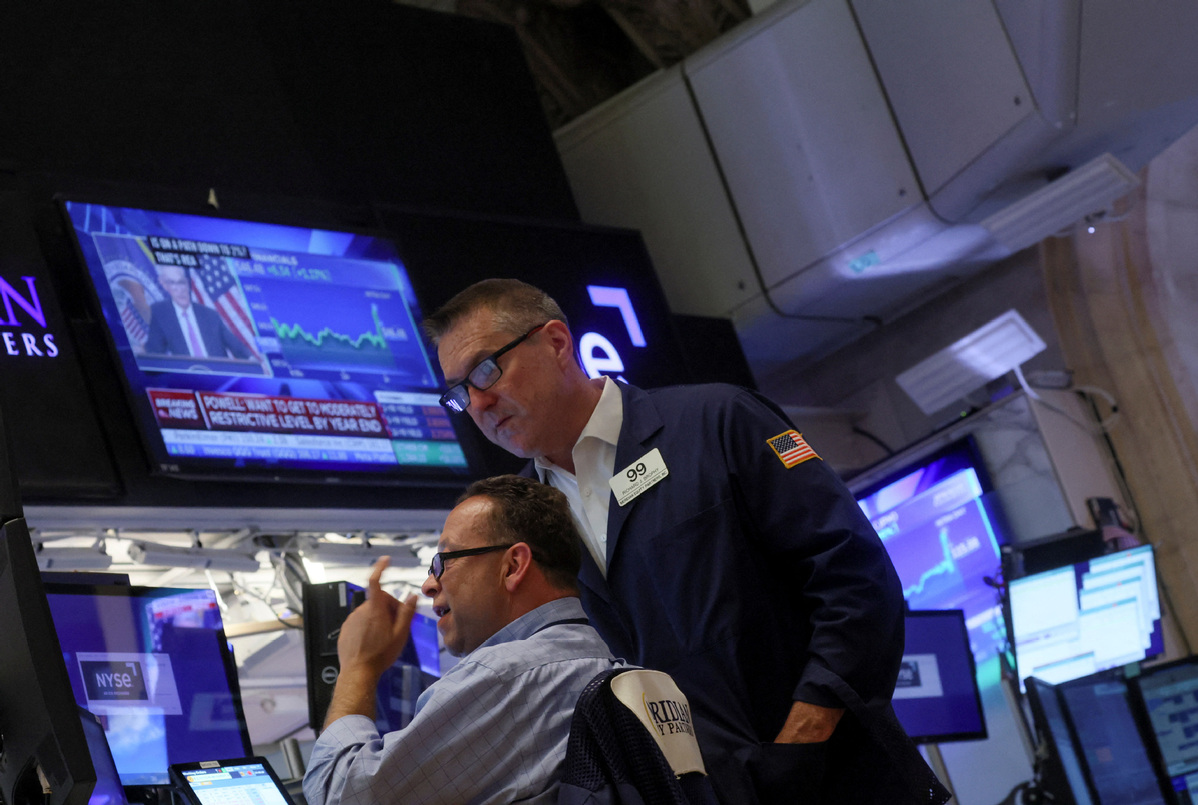Latest bold rate hike by Fed will test grip of inflation on US


The latest interest-rate increase by the US Federal Reserve should provide a clearer picture of how much impact the extra cash sloshing around in the economy from COVID-19 pandemic stimulus has had on inflation.
The central bank raised its benchmark overnight interest rate by three-quarters of a percentage point (75 basis points) on Wednesday in an effort to cool the most intense burst of inflation since the 1980s, with "ongoing increases" in borrowing costs still ahead despite some signs of a slowing economy.
"Inflation remains elevated, reflecting supply and demand imbalances related to the pandemic, higher food and energy prices, and broader price pressures," the Federal Open Market Committee (FOMC) said as it lifted its policy rate to a range of between 2.25 percent and 2.50 percent in a unanimous vote. The FOMC did note, however, that "recent indicators of spending and production have softened".
The American economy is still working through pent-up demand from COVID-19-related suppression of economic activity. That demand also was heightened by global supply chain backlogs, which led to fewer goods on shelves.
Coupled with trillions of dollars in the government’s pandemic-stimulus funding, demand is still making its way through the proverbial python.
In March, the Federal Reserve Bank of San Francisco estimated that government stimulus may have added three percentage points to the national inflation rate.
"Inflation is leading to record-low consumer sentiment, but consumers are still spending," wrote Greg Daco, chief economist at EY-Parthenon, adding that the US economy is currently "a world of paradox".
"Since the onset of the pandemic, lawmakers have spent about $6 trillion on various income-support programs for households and businesses," wrote Donald Luskin, chief investment officer of TrendMacro, in a piece in The Wall Street Journal.
"That all dropped straight into the bank accounts that are part of M2, which also grew about $6 trillion over precisely the same period."
M2 is cash in circulation along with liquid bank and money-market fund balances.
Luskin quoted famed economist Milton Friedman who said that "inflation is always and everywhere a monetary phenomenon".
Growth in M2 peaked at an astronomical 27 percent in February 2021, but has been falling since, Luskin said.
One area where higher interest rates have an immediate impact is the housing market.
Signed contracts for the purchase of existing homes plunged 20 percent in June compared with a year ago, the National Association of Realtors (NAR) said Wednesday.
Pending home sales also fell 8.6 percent in June from May, far more than expected.
The interest rate on 30-year mortgages has recently averaged 5.54 percent, according to Freddie Mac, chartered by Congress in 1970 to support the US housing finance system.
"Contract signings to buy a home will keep tumbling down as long as mortgage rates keep climbing, as has happened this year to date," said Lawrence Yun, chief economist for NAR.
The Fed has raised its policy interest rate by 225 basis points this year as it battles a 1980s-level breakout of inflation — with that decade’s approach to monetary policy.
With the most recent consumer price index data showing prices rising at more than 9 percent, investors expect the Fed to raise rates by at least a half-percentage point at its September meeting.
"I don’t think the economy is in recession right now," Federal Reserve Chair Jerome Powell said Wednesday at a post-FOMC meeting news conference.
Powell repeatedly said that the Fed’s target goal for inflation is 2 percent.
"The economy and the country have been through a lot over the past two and a half years and have proved resilient. It is essential that we bring inflation down to our 2 percent goal if we are to have a sustained period of strong labor market conditions that benefit all," Powell said.
Salman Ahmed, global head of macro for Fidelity International in London told Reuters: "The continued focus on inflation and labor-market strength was striking in the press conference comments as the two main drivers behind the pace of hiking. We think a significant slowdown is already in the pipeline and will start to show in hard data in the coming weeks and months.
"However, continued strength in the labor market — with only very tentative signs of some easing in demand and supply pressures — and the Fed’s focus on lagging hard data means another 75bp hike is possible at the next meeting. The risk here is that the Fed tightens policy too far too quickly, making a hard landing inevitable."
Seema Shah, chief global strategist at Principal Global Investors, wrote that "with the labor market still a picture of strength, wage growth still uncomfortably high and core inflation set to decline at a glacially slow pace, the Fed certainly cannot stop tightening, nor can it downshift gears too much".
Brian Coulton, chief economist at Fitch Ratings, said, "The Fed’s statement acknowledged the recent softening in activity data but this is given short shrift in the presence of what is still a very robust labor market and unrelenting inflation pressures.
"Given where core inflation and the unemployment rate (3.6 percent) currently stand, this underscores that monetary policy adjustment still has quite a long way to go. Market expectations that the Fed may be cutting rates again next year look premature."
Gina Chon, a columnist for Reuters’ Breaking Views, wondered if Powell could face political ramifications from the rapid rate increases.
"What’s the cost if Powell pushes too far? For him, not much. He can’t be removed, short of misconduct, until 2028. He also has broad backing from Congress. Powell was reconfirmed in his current role in May by 80 of the 99 senators who voted," she wrote.
"He has also schmoozed more effectively than other Fed chiefs. In his first year as chair in 2018, he had nearly 100 meetings with members of Congress, while his predecessor, Janet Yellen, had 22 such gatherings, according to their public calendars."
Chon added though that "politicians can pester Fed chiefs in other ways".
She mentioned Paul Volcker, who presided over a 19 percent effective federal funds rate and two recessions in the 1980s and faced several resolutions in Congress demanding his impeachment.
Reuters contributed to this story.

































